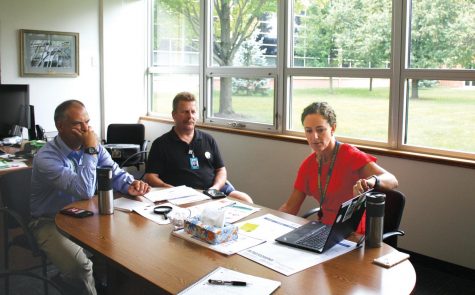Contamination halts GBN recycling

Reduce. Reuse. Recycle. To senior Francine Dadrass, recycling had always been an obvious choice to make — a choice she had assumed Glenbrook North was making with blue bins present in almost every classroom.
“It was confusing once I found out about [GBN not recycling] because I thought every time I recycled [in school], I was doing something,” Dadrass said.
According to GBN Plant Manager Dan Whisler, the largest contributor of contamination was students and staff disposing of plastic cups and bottles with leftover liquid into recycling bins. More than a few drops of liquid left in a drink like Gatorade or coffee renders the entire content of a bin useless.
Environmental Club Member Dani Bosse said she has made an effort to uphold an eco-friendly lifestyle, through carrying a portable, reusable metal straw with her, in addition to owning sustainable clothing. After finding out that GBN was not recycling, she found it frustrating that students were not made aware of the situation earlier.
“[The recycling bins] were definitely still there when GBN wasn’t recycling and it’s an issue because there were literally signs around the school saying, ‘Myth busted: GBN does recycle,’ that Environmental Club made because they didn’t know,” said Bosse. “It was terrifying because we’ve been lying to everyone.”
According to Waste Management, GBN’s garbage disposal partner, China imposed a policy in 2018 where U.S. recycling was required to pass as 80 percent clean in order to be accepted.
Whisler said China’s new policy prompted difficulties with recycling at GBN. Waste Management was no longer able to send the school’s recycling overseas and would give GBN $138 fines for each pickup load of recycling that was contaminated. The fines and inability to successfully recycle contributed to the school’s decision to ultimately combine all contents from the blue bins into general trash bins, which were then accepted by Waste Management.
According to Environmental Club Sponsor Amy Ludolph, she became concerned last year regarding the school’s recycling after she observed maintenance staff using one bin to collect waste from both the garbage and recycling bins. This suspicion grew after her Advanced Placement Environmental Science classes conducted a lab last March that tracked waste within the science classrooms. She and her students discovered that about 25 pounds of cans and bottles, along with over 25 pounds of paper were thrown in the trash in just one week.
“I’ve been recycling since I was a kid … so for me, not recycling feels like me not wearing my seat belt,” said Ludolph. “I was really alarmed. I couldn’t sleep for a couple days. Then I started figuring out what I can do to fix this.”
Lawford Anderson, professor of earth science at Boston University, said in a phone interview that it is harmful for someone not to recycle for a multitude of reasons. Plastic breaks down, but does not decay. So, when plastic is not recycled, it can transfer into lakes and oceans, get into the food we eat and kill animals.
According to Whisler, after collaborating with Ludolph and Associate Principal Scott Williams, a plan was devised, and scheduled to be implemented the week of Sept. 23 to replace the blue recycling bins in every classroom with green bins for paper only. Larger versions of these green bins were planned to be placed near printers in common areas such as the English Resource Center and Math Resource Center. The new bins cost over $4,500 in total and are expected to increase GBN’s recycling output, as the narrow slot on the lid will make it difficult for any waste to potentially contaminate the bins.
Williams said in order to improve with recycling, the process of disposing of the correct materials needs to be made easier for students and staff. The green bins will allow them to look at the bin and instantly know what is supposed to go inside.
“The barrier to recycling is that it needs to be made almost where people don’t need to think about it,” said Williams. “We want to do good, but we are also busy. We don’t want to take an extra few steps, we don’t want to think, so it has to be made crystal clear.”
According to Dadrass, she believes contamination was occurring because students are unaware of what to recycle. She thinks GBN could contribute to raising awareness on not just recyclable materials, but environmental issues as a whole through activities or announcements.
“This year, [environmental efforts] should broaden out so everyone in the school is involved,” said Dadrass. “Even just recycling is a small step and we should be able to do more to take steps forward, not backward.”

